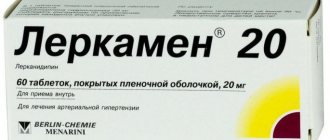Pharmacological properties of the drug Moxifloxacin
Antibacterial drug of the fluoroquinolone group. Has a bactericidal effect. The mechanism of action is due to the inhibition of bacterial topoisomerases II and IV, which leads to disruption of the DNA synthesis of the microbial cell. In vitro, it is active against a wide range of gram-negative and gram-positive bacteria, anaerobes, acid-fast bacteria and atypical forms, including Mycoplasma, Chlamydia, Legionella. Effective against bacteria resistant to β-lactam and macrolide antibiotics. Gram-positive bacteria are sensitive to moxifloxacin - Staphylococcus aureus (including strains sensitive to methicillin), Streptococcus pneumoniae (including strains resistant to penicillin and macrolides), Streptococcus pyogenes (group A), Streptococcus milleri, Streptococcus mitior , Streptococcus agalactiae, Streptococcus dysgalactiae, Staphylococcus cohni, Staphylococcus epidermidis (including strains sensitive to methicillin), Staphylococcus haemolyticus, Staphylococcus hominis, Staphylococcus saprophyticus, Staphylococcus simulans, Corynebacterium diphtheriae ; gram-negative bacteria - Haemophilus influenzae (including strains producing β-lactamases), Haemophilus parainfluenzae, Klebsiella pneumoniae, Moraxella catarrhalis (including strains producing β-lactamases), Escherichia coli, Enterobacter cloacae; Bordetella pertussis, Klebsiella oxytoca, Enterobacter aerogenes, Enterobacter agglomerans, Enterobacter intermedius, Enterobacter sakazakii, Proteus mirabilis, Proteus vulgaris, Morganella morganii, Providencia rettgeri, Providencia stuartii; anaerobic bacteria - Bacteroides distasonis, Bacteroides eggerthii, Bacteroides fragilis, Bacteroides ovatus, Bacteroides thetaiotaomicron, Bacteroides unoformis, Fusobacterium spp., Porphyromonas spp. (including Porphyromonas anaerobus, Porphyromonas asaccharolytica, Porphyromonas magnus), Prevotella spp., Propionibacterium spp., Clostridium perfringens, Clostridium ramnosum . Moxifloxacin is also active against Chlamydia pneumoniae, Mycoplasma pneumoniae, Legionella pneumophila, Caxiella burnettii . It has a clinically significant post-antibiotic effect against gram-positive and gram-negative microorganisms (on average 2 hours). When taken orally, it is quickly and almost completely absorbed from the gastrointestinal tract (food intake does not affect the absorption of moxifloxacin). Absolute bioavailability is 86–92%. The maximum concentration in the blood serum is reached after 1–2.5 hours and after oral administration of 400 mg of moxifloxacin is 2.5–4.98 mg/l. Plasma protein binding is 39.4–48%. It is well distributed in tissues and body fluids, the volume of distribution is 3–3.5 l/kg. Creates high concentrations in bronchial secretions, alveolar macrophages, the mucous membrane of the maxillary sinus and bronchial secretions, which exceed the level of moxifloxacin in the blood. Metabolized in the liver without the participation of the cytochrome P450 system with the formation of two inactive metabolites - acetyl glucuronide and N-sulfate, the first of which binds to proteins by 89.5%, and the second practically does not bind to albumin (4.8%). The half-life is 12–14 hours. Total clearance is 254 ml/min, renal clearance is 50 ml/min. 42% is excreted in the urine (22% unchanged, 20% in the form of metabolites), as well as in bile (12% unchanged, 27% in the form of metabolites).
Reviews
First of all, it is worth turning to the reviews of doctors and the results of using this drug at the Research Institute of Urology of the Ministry of Health of the Russian Federation in Moscow for urological diseases.
Moxifloxacin is the most active drug of the new generation of quinolones. Ciprofloxacin in activity and spectrum of antimicrobial action . In terms of its effect on atypical microorganisms, it is superior to Levofloxacin , Co-amoxiclav , Minocycline , Cefuroxime , Lomefloxacin , Ofloxacin , Azithromycin . In relation to chlamydia, the effect is comparable to Trovafloxacin, Gatifloxacin and Grepafloxacin . With prostatitis , a mixed chlamydial-mycoplasma flora is often detected, and given the spectrum of activity, Moxifloxacin is widely used for prostatitis. It quickly enters the blood, has high bioavailability, penetrates well through cell membranes, having a detrimental effect on intracellular pathogens. It remains in tissues for a long time and does not lose activity, maintaining high bactericidal concentrations. Thus, the level in the prostate and urogenital tract when taking 400 mg is 3.7. According to the results of the Research Institute of Urology of the Ministry of Health of the Russian Federation, the clinical effectiveness of the drug in the treatment of prostatitis was 95.7%.
Use of the drug Moxifloxacin
Take 400 mg orally, regardless of food intake, once a day for 5–10 days. The IV drug is prescribed at a dose of 400 mg once a day. The duration of treatment depends on the indications for use and is: for chronic bronchitis in the acute phase - 5 days, for community-acquired pneumonia - 10 days, for acute sinusitis - 7 days, for infections of the skin and soft tissues - 7 days. Moxifloxacin can be used intravenously throughout the entire course of treatment. It is possible to use it in the form of a solution for infusion at the initial stages of treatment, followed by a transition to taking moxifloxacin orally. The solution for infusion should be administered intravenously slowly over 60 minutes.
Moxifloxacin analogs
Level 4 ATX code matches:
Siflox
Hyleflox
Leflobakt
Lefoccin
Gatifloxacin
Ofloxacin
Faktiv
Tigeron
Lebel
Zanotsin
Lomefloxacin
Eleflox
Lomflox
Pefloxacin
Tsiprobay
Sparflo
Tariwid
Zoflox
Abaktal
Levofloxacin
Moxifloxacin-Credopharm, Avelox, Moxifloxacin-Norton, Moxifluor 400, Moxifloxacin-Pharmex, Mofloxin Lupine, Tevalox . These analogues of Moxifloxacin have one release form, but are not always available in the pharmacy chain. In terms of their effectiveness, they do not differ from brands and are much cheaper than them.
Side effects of the drug Moxifloxacin
From the digestive system: often - abdominal pain, nausea, diarrhea, vomiting, dyspepsia, taste disturbances, changes in the results of liver function tests; rarely - dry mouth, flatulence, constipation, candidiasis of the oral mucosa, anorexia, stomatitis, glossitis, gastrointestinal dysfunction; in some cases - gastritis, discoloration of the tongue, dysphagia, transient jaundice. From the central nervous system and peripheral nervous system: often - headache, dizziness; rarely - insomnia, nervousness, drowsiness, anxiety, tremor, paresthesia; in isolated cases - hallucinations, depersonalization, increased muscle tone, coordination disorders, agitation, amnesia, aphasia, emotional lability, sleep disorders (including parasomnias), speech disorders, cognitive impairment, hypoesthesia, convulsions, confusion, depression. From the cardiovascular system: often - prolongation of the QT in patients with concomitant hypokalemia; rarely - tachycardia, hypertension (arterial hypertension), palpitations, prolongation of the QT with normal potassium levels in the blood serum; in some cases - arterial hypotension, vasodilation, peripheral edema. From the blood system: rarely - leukopenia, increased prothrombin time, eosinophilia, thrombocytosis; in isolated cases - decreased thromboplastin levels, decreased prothrombin time, thrombocytopenia, anemia. Metabolism: rarely - increased amylase activity; in isolated cases - hyperglycemia, hyperuricemia, increased LDH activity. From the musculoskeletal system: rarely - arthralgia, myalgia; in isolated cases - arthritis, tendinopathy. From the respiratory system: rarely - shortness of breath; in isolated cases - BA. From the reproductive system: rarely - vaginal candidiasis, vaginitis. From the urinary system: in isolated cases - impaired renal function. From the senses: in isolated cases - visual impairment, amblyopia, loss of taste sensitivity, parosmia. On the skin: rarely - rash, itching, increased sweating. Allergic reactions: in isolated cases - urticaria. Local reactions: often - swelling, allergic reactions, inflammation, pain in the area of drug administration, rarely - phlebitis at the infusion site. Other: rarely - asthenia, candidiasis, general discomfort, chest pain; in some cases - pain in the pelvis, swelling of the face, back pain, abnormal laboratory tests, pain in the legs.
Contraindications
Contraindications for the use of Moxifloxacin eye drops include:
- hypersensitivity to quinolones;
- age up to 1 year;
- breastfeeding period;
- pregnancy.
When taking eye drops topically, in some cases side effects are observed: burning after instillation, a feeling of fog before the eyes, excessive dryness and redness of the sclera, itching, allergic reactions, headache and discomfort.{banner_gorizontalnyy2}
In all of the above cases, you must seek advice from the doctor who prescribed the treatment. Depending on the intensity of side effects, the doctor decides to replace or discontinue the drug.
Attention!
If allergic reactions occur, use of Moxifloxacin should be stopped immediately and medical attention should be sought.
Special instructions for the use of the drug Moxifloxacin
The use of quinolone drugs is associated with a possible risk of developing seizures. Moxifloxacin should be used with caution in patients with central nervous system diseases that predispose to seizures. Moxifloxacin should not be prescribed to patients with epilepsy. When using moxifloxacin, a slight prolongation of the QT on the ECG is possible. Do not exceed a dose of 400 mg and an infusion time of 60 minutes. Prolongation of the QT is associated with an increased risk of ventricular arrhythmias, including torsade de pointes. Caution should be exercised when prescribing moxifloxacin to patients with diseases accompanied by an increased risk of developing ventricular arrhythmias, with congenital or acquired diseases accompanied by prolongation of the QT , or receiving drugs that potentially slow intracardiac conduction. Due to the risk of arrhythmia in patients with clinically significant bradycardia and signs of acute myocardial ischemia, moxifloxacin should be used with caution. Considering that during fluoroquinolone therapy in elderly patients and patients receiving corticosteroids, there is a risk of tendon rupture or tenosynovitis, if pain or signs of inflammation of the tendon appear, it is recommended to stop using moxifloxacin. There is a risk of developing hypersensitivity reactions, including anaphylaxis, during the initial use of the drug. In such cases, the administration of moxifloxacin should be stopped immediately and appropriate emergency measures should be taken. Patients with impaired renal function (creatinine clearance ≤30 ml/min) do not require dosage adjustment. For moderately severe liver dysfunction (Child-Pugh functional class A, B), no dosage adjustment is required. In severe liver dysfunction, moxifloxacin should be used with extreme caution. If moxifloxacin is necessary, breastfeeding should be discontinued.
Drug interactions Moxifloxacin
With the simultaneous use of moxifloxacin and GCS, the risk of developing tendovaginitis or tendon rupture increases. There was no interaction of moxifloxacin with probenecid, warfarin, or oral contraceptives. No clinically significant interaction has been established between moxifloxacin and glibenclamide. Moxifloxacin slightly changes the pharmacokinetic parameters of digoxin. When used concomitantly, moxifloxacin does not affect the pharmacokinetics of theophylline. With parenteral use of morphine and moxifloxacin, there is no decrease in the bioavailability of the latter. Moxifloxacin infusion solution is incompatible with the following infusion solutions: sodium chloride 10%, sodium chloride 20%, sodium bicarbonate 4.2%, sodium bicarbonate 8.4%.
Moxifloxacin overdose, symptoms and treatment
There were no side effects observed in healthy volunteers with single use of moxifloxacin in doses of up to 1.2 g or at a dose of 600 mg/day for 10 days. In case of overdose, symptomatic therapy is carried out in accordance with the clinical situation. In case of oral overdose of moxifloxacin, it is advisable to use activated carbon. After intravenous administration, activated charcoal slightly (approximately 20%) reduces the systemic exposure of moxifloxacin.
List of pharmacies where you can buy Moxifloxacin:
- Moscow
- Saint Petersburg
Moxifloxacin price, where to buy
Moxifloxacin can be purchased in the Russian Federation in the form of the drug Avelox . You can buy it in Moscow in pharmacies provided on the website of the Federal Information Service www.poisklekarstv.ru. The price of Moxifloxacin (Avelox) 400 mg N5 in different pharmacies ranges from 759 rubles. up to 850 rub.
- Online pharmacies in RussiaRussia
- Online pharmacies in UkraineUkraine
ZdravCity
- Moxifloxacin-SOLOpharm solution for inf.
1.6 mg/ml vial. 250 ml No. 20 for hospitalsGrotex LLC RU 15466 rub.order - Moxifloxacin-SOLOpharm solution for inf. 1.6 mg/ml vial. 250ml No. 1 (ind.pack) Grotex LLC RU
RUB 862 order
- Moxifloxacin-Optic eye drops 0.5% 5ml dropper bottle JSC "LEKKO"
155 rub. order
- Moxifloxacin tablets p.p.o. 400 mg 5 pcs. Ozone LLC
RUB 505 order
- Moxifloxacin Canon tablets p.p.o. 400 mg 5 pcs. Canonpharma Production CJSC
481 rub. order
show more
Pharmacy24
- Moxifloxacin Sandoz 400 mg No. 7 tablets C. K. Sandoz S. R. L., Rumunia
237 UAH. order



